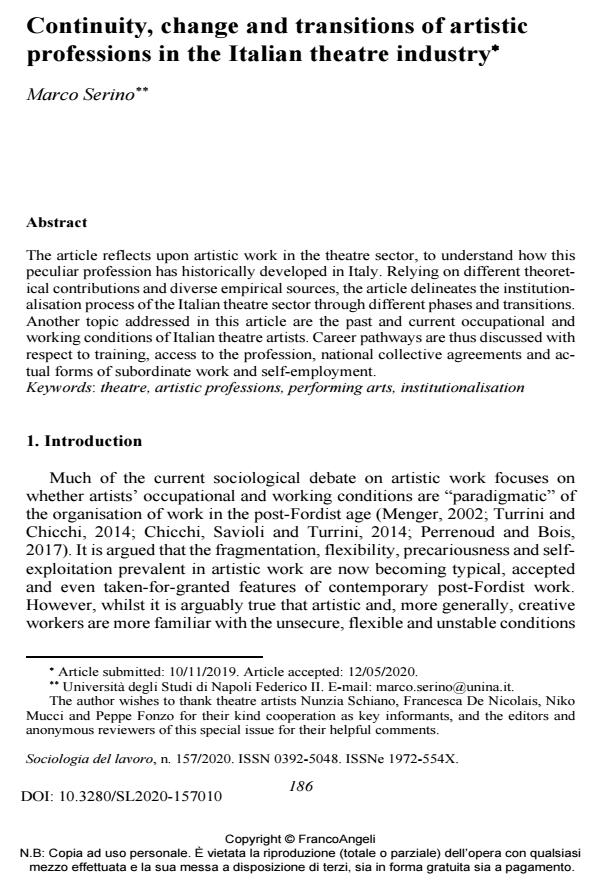Continuity, change and transitions of artistic professions in the Italian theatre industry
Titolo Rivista SOCIOLOGIA DEL LAVORO
Autori/Curatori Marco Serino
Anno di pubblicazione 2020 Fascicolo 2020/157
Lingua Inglese Numero pagine 20 P. 186-205 Dimensione file 265 KB
DOI 10.3280/SL2020-157010
Il DOI è il codice a barre della proprietà intellettuale: per saperne di più
clicca qui
Qui sotto puoi vedere in anteprima la prima pagina di questo articolo.
Se questo articolo ti interessa, lo puoi acquistare (e scaricare in formato pdf) seguendo le facili indicazioni per acquistare il download credit. Acquista Download Credits per scaricare questo Articolo in formato PDF

FrancoAngeli è membro della Publishers International Linking Association, Inc (PILA)associazione indipendente e non profit per facilitare (attraverso i servizi tecnologici implementati da CrossRef.org) l’accesso degli studiosi ai contenuti digitali nelle pubblicazioni professionali e scientifiche
The article reflects upon artistic work in the theatre sector, to understand how this peculiar profession has historically developed in Italy. Relying on different theoret-ical contributions and diverse empirical sources, the article delineates the institu-tionalisation process of the Italian theatre sector through different phases and transitions. Another topic addressed in this article are the past and current occupa-tional and working conditions of Italian theatre artists. Career pathways are thus discussed with respect to training, access to the profession, national collective agreements and actual forms of subordinate work and self-employment.
L’articolo riflette sul lavoro artistico nel settore teatrale per capire come questa particolare professione si sia storicamente sviluppata in Italia. Basandosi su diversi contributi teorici e diverse fonti empiriche, l'articolo delinea il processo di istituzionalizzazione del settore teatrale italiano attraverso diverse fasi e transizioni. Un altro tema affrontato sono le condizioni occupazionali e lavorative passate e presenti degli artisti teatrali italiani. I percorsi di carriera sono quindi discussi per quanto riguarda la formazione, l'accesso alla professione, i contratti collettivi nazionali e le forme effettive di lavoro subordinato e di lavoro autonomo.
Parole chiave:Teatro, professioni artistiche, arti dello spettacolo, istituzionalizzazione
- Stuck inside: Context, precarity and the effect of COVID-19 on Romanian performers Alina Maria Pavelea, Bogdana Neamțu, in European Journal of Cultural Studies /2024 pp.1249
DOI: 10.1177/13675494231216402 - Traces of solidarity: performing artists’ efforts against individualisation and isolation during Covid-19 pandemic Emanuela Naclerio, in Sciences & Actions Sociales /2022 pp.19
DOI: 10.3917/sas.018.0005 - Self-entrepreneurship in uncertain futures: The case of performing artists in Italy Emanuela Naclerio, in International Sociology /2023 pp.142
DOI: 10.1177/02685809221139111
Marco Serino, Continuity, change and transitions of artistic professions in the Italian theatre industry in "SOCIOLOGIA DEL LAVORO " 157/2020, pp 186-205, DOI: 10.3280/SL2020-157010